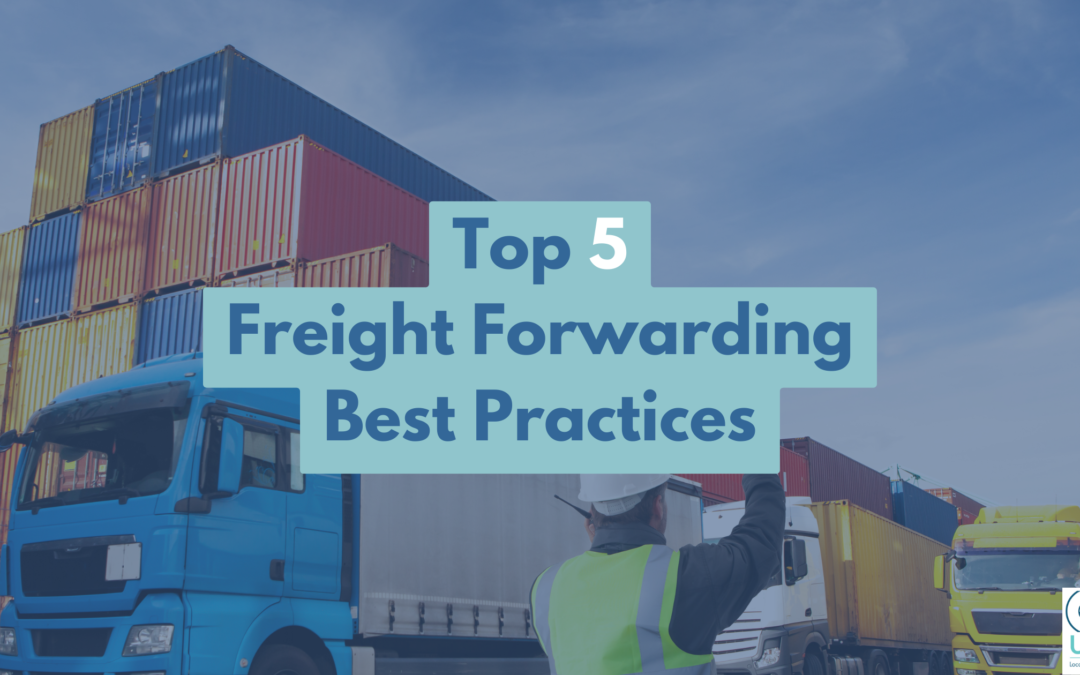
Top 5 Freight Forwarding Best Practices
Whether you are a seasoned veteran or planning your first international shipment, the freight forwarding process can be challenging to navigate. Even the slightest hiccup along the way can cause significant delays, damaged goods, and higher costs.
Given these high stakes, it is vital to minimize your chances of encountering problems. By following industry best practices, you can avoid many headaches and be better prepared to handle the unexpected. Here are five ways to help ensure your next shipment arrives on time and within budget.
Estimate, Do Not Guesstimate
We all know how sensitive costs are when doing business. Many factors determine your freight forwarding costs, including:
- Mode of transport: The method you use to transport your goods ultimately depends on the cargo you are shipping, the distance for transport, your budget, and other requirements. Each form of transportation features different rates, ranging from air freight at the high end to ocean freight as the most cost-effective.
- Shipping distance: Shipping distance is another critical factor in your freight forwarding costs. Storage costs, fuel charges, and port tariffs increase costs for transporting goods across borders. Also, note that more popular shipping routes are typically more affordable than less utilized shipping routes.
- Type of cargo and weight: Other critical factors include the type of cargo and its weight. If your cargo is perishable, oversized, requires special handling, or is hazardous, your costs will be higher. Your chargeable weight will be determined by the greater of your actual weight or the dimensional weight of your goods.
What You Can Do
Calculating your costs is not always easy, as many variables affect this calculation. This is why it’s critical to ensure you are working with current information. Before determining your rates, make sure you have the most current data available. Otherwise, you risk facing higher charges and smaller margins.
While air transport is generally quite reliable regarding departure and arrival times, delays can happen. Inclement weather, congestion, and political events can cause bottlenecks, which can have severe consequences if you are unprepared. Be sure to factor your timeline into shipping decisions to ensure you have room to handle the unexpected.
Confirm the export and import tariffs on your goods with each relevant country involved in your shipping process. These extra charges change and can negatively impact your bottom line. Although double-checking this information can take time, errors represent avoidable headaches.
Watch Your Regulations and Licensing
When freight forwarding crosses borders, your cargo must meet all applicable regulations of the destination country. Determining which rules apply to your shipment can be a complex process. While many standards must be met regardless of what you ship, other regulations apply to only specific goods.
For example, exports from the U.S. are subject to many regulations and export control laws. Dual-use commodities and technology subject to the Export Administration Regulations (EAR) could require you to secure a license for export. Goods related to national defense demand a license under the International Traffic in Arms Regulations (ITAR).
Penalties for failing to comply with regulations and licensing requirements can be steep. In addition to the business-related problems caused by such oversights, your goods may be confiscated, and you may even face fines and jail time.
What You Can Do
Confirm with the destination country any regulations, standards, and licensing requirements you need for shipping your goods before beginning the freight forwarding process. Check into whether any imminent changes are likely to affect your shipment to help mitigate any potential issues.
Most industries are controlled to some extent, and the degree of monitoring varies according to the item. Double-check to be sure that you have the proper licensing required for importing or exporting products. Also, ensure your goods are packed properly to meet all shipping requirements.
Consider how international events and international relations could affect the shipping of your goods, and factor this uncertainty into any freight forwarding decision.
Document, Document, Document
Specific documents are required in global shipping for various reasons. First, documents make up the contract of carriage, including all particular clauses related to the transportation of goods. This paperwork also serves as proof that goods have been delivered. Not only that, but it also verifies that, even after sometimes weeks of transport, the goods have been delivered in acceptable condition. Perhaps most importantly, your documents serve as proof of ownership for the cargo being transported.
Here is a look at some of the most important documents used in freight forwarding:
- Import/export declaration: An import or export customs declaration states the essential details of the goods being transported. It is crucial for customs clearance and in calculating any duties that apply to a shipment.
- Commercial invoice: A commercial invoice is one of the most important documents in shipping goods internationally by sea. It provides proof of sale from the exporter (seller) to the importer (buyer). This document is needed for customs clearance.
- Bill of lading: A bill of lading is a transportation contract. It states that the cargo carrier received goods from the shipper in usable condition and gives the document holder rights to control and manage the goods.
- Certificate of origin: This document states which country the goods were manufactured in. It includes product information, destination, and country of export, and it helps determine whether a shipment is eligible for import and any duties that may apply.
What You Can Do
Knowing what forms you need is not always an easy task. Ensure that your customs documentation is accurate, up to date, and complete.
Collecting your documentation is one of the simplest ways to save yourself a lot of time, money, and headaches later on. It is much more cost-effective to get it right the first time than to collect the required paperwork as your cargo sits in a warehouse, incurring storage costs. After all, a pinch of prevention is better than a pound of cure.
The First Mile is as Important as the Last Mile
Freight forwarding involves many moving parts that often include the combination of rail, road, air, and sea freight. The delivery process is complex and requires the successful delivery of goods at every step to ensure each shipment reaches its final destination safely.
Businesses have realized the importance of last-mile delivery in providing a positive customer experience. However, the first mile is often overlooked as it does not involve the same intimate contact with customers.
Common Oversights of First-Mile Logistics
Given the importance of the first mile to the cost of goods sold (COGS) and its impact on every subsequent step in the freight forwarding process, its lack of prioritization in many companies represents an incredible opportunity to improve business practices.
Here are some of the areas that often get overlooked in first-mile logistics.
- Proper packaging: It is crucial to properly package goods to prevent damage or loss during transit or the loading process.
- Correct labeling: Accurate labeling is essential to guarantee suitable shipping and handling of goods.
- Planning for congestion: Careful scheduling is vital to ensure the smooth flow of shipments.
- Preparing documentation: As mentioned earlier, documentation is a critical area in freight forwarding. Not preparing everything that’s required can cause delays, fines, and other penalties.
What You Can Do
Do not make the mistake of overlooking any step of your freight forwarding process — from start to finish. Your costs depend on each step and not just the final mile. So spend your time and money looking for ways to optimize each node of the transportation process.
Work With the Right Partners
Every shipment differs in terms of services required for successful transport. It takes a great deal of finesse to navigate the logistics landscape to determine the optimal solution for your needs.
With so many stakeholders involved and steps along the path, it is vital to work with the right people. Tapping into experienced partners and established networks makes freight forwarding much more efficient and problems easier to avert.
But choosing partners can sometimes feel like traversing a field full of land mines. How can you choose the right partners for your needs? Many areas need attention to make sure you choose what is best for your business:
- Check reviews: You should not base your judgment of a potential partner solely on its website. Collecting feedback from former clients is often a much more reliable source of information.
- Do not overemphasize fees: Of course, your costs are essential. But low cost should not be your only criterion in choosing partners. Be sure to factor in experience, delivery time, insurance, and services offered.
- Examine expertise: You need to consider what exactly you need. There is no need to work with the best air freight logistics provider if transport cost is critical to your business. Seek out experts in your areas of need.
What You Can Do
It often makes sense to partner with logistics experts to realize cost savings and added convenience. Choosing partners with extensive logistics networks can make your life much easier. Spend the time up front to select partners that best serve your needs.
We Are Here For You
We know how complex freight forwarding can be. But OL USA can help. Sign up for our newsletter or contact us today to see how we can help your brand. We’ll work with you to determine your transportation and freight forwarding needs so we can tailor our services to suit you best.


